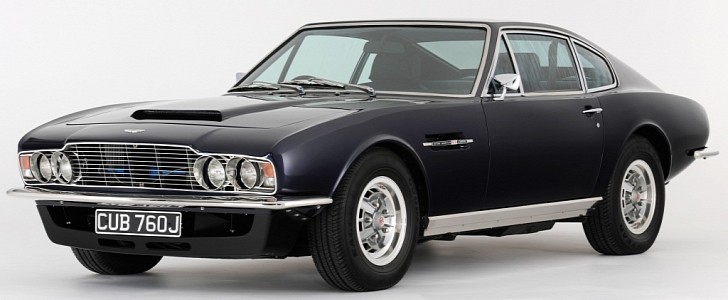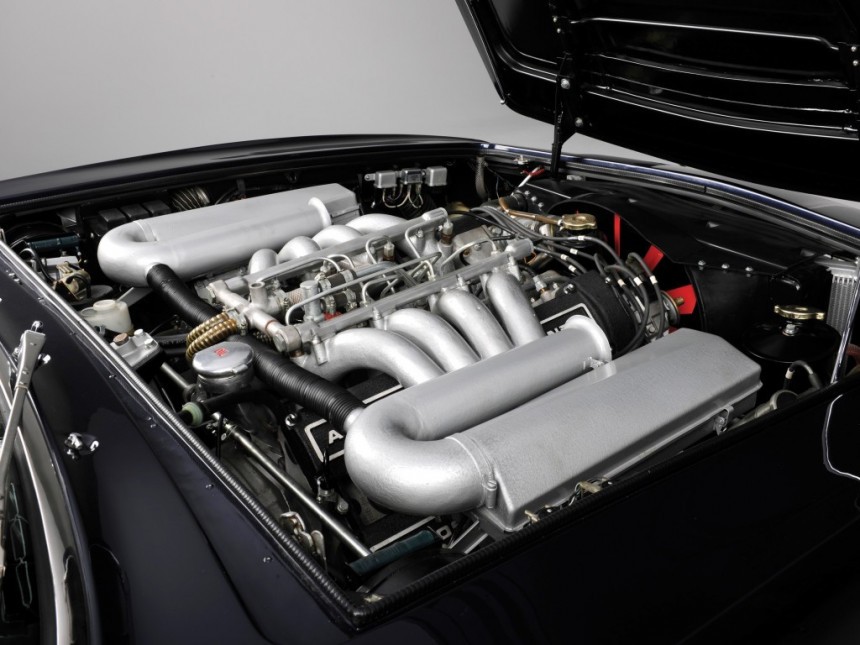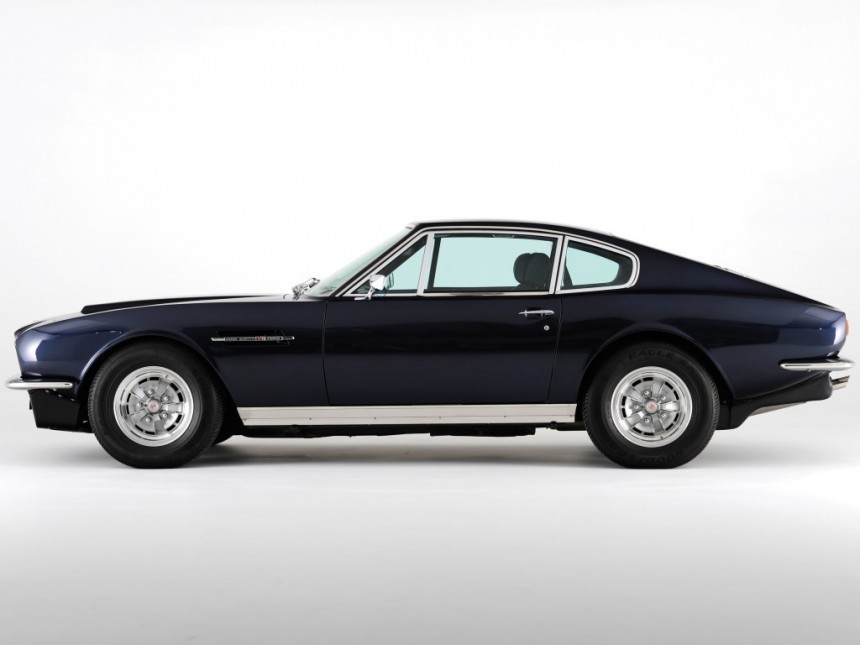The Oldsmobile Rocket 88 is rightfully considered the genesis point of the muscle car, whereas the Pontiac GTO firmly established the segment in the American public’s conscience. Meanwhile, across the blue pond known as the Atlantic Ocean, the peeps at Touring Superleggera were commissioned by Aston Martin in 1966 to design the long-due replacement for the DB6.
Originally intended with a thumpin’ great V8 featuring a DOHC valvetrain, the DBS launched to much critical acclaim on September 25th, 1967 with the straight-six engine of the DB6. Developed by the legendary engineer Tadeusz "Tadek" Marek, the six-cylinder mill didn’t cut the mustard.
The V8 was not ready in time for the start of production, but come 1969, the all-aluminum powerplant with double overhead camshafts debuted in the DBS V8. Aston Martin’s flagship is widely considered a Ford Mustang with British flair, which is understandable in every respect. The rear quarters are probably the most obvious connection between these legendary models, followed by the marvelous side view and commanding road presence.
Extremely different from prior Aston Martins, the DBS V8 wasn’t a muscle car per se. Although the 5.3-liter motor had 16 more valves than a big-block V8 from General Motors, the LS6 engine in the ultra-collectible 1970 Chevelle SS 454 was tremendously more powerful and torquier as well.
But as opposed to Chevrolet’s strip-slaying machine, Aston Martin didn’t vie for a place in the muscle car pantheon. The Brits were doing their own thing, reinventing their lineup with striking design cues and the company’s first-ever V8 engine. Oh, and did you know that Aston Martin held the title of fastest four-seat production car in the world with the DBS V8?
Fitted with a stronger manual transmission than the six-cylinder variant, GR70VR15 Cinturato tires from Pirelli, and upgraded brake discs, the DBS V8 totaled only 402 examples. The DBS V8 nameplate was dropped in favor of simply V8 for 1972. Retroactively named Series 2, the facelifted model switched from carburetors to Bosch fuel injection. The switch to a mesh grille and twin headlights also needs to be mentioned, along with DBS V8 badging for the first 34 cars of 288 ever built at Newport Pagnell.
The British automaker switched back to carburetors for the Series 3 in 1973, which is weird at first glance. Context, however, is of the essence here.
Aston Martin couldn’t make the Bosch-supplied fuel injection system work correctly, which is why the fuel-injected V8 couldn’t pass the stricter emissions standards in California. On the other hand, twin-choke carburetors are responsible for the most iconic styling cue of the Series 3: the prominent hood scoop. Rated at 310 horsepower and capable of hitting 60 miles per hour (97 kilometers per hour) in 5.7 seconds with the manual box, this fellow lasted through October 1978 with 967 examples to its name.
Further emissions regulations downgraded the 5.3-liter engine to 288 horsepower in 1976, then Aston Martin introduced the 305-horsepower Stage 1 option the following year, consisting of a new exhaust and camshafts. The Series 4, also known as the Oscar India specification, changed from a scoop to a power bulge whereas the Series 5 flaunted a flatter hood due to smooth and reliable Weber Marelli electronic sequential fuel injection.
Introduced in 1977 and phased out in 1989, the V8 Vantage is lovingly nicknamed Britain’s first supercar because of its top speed of 170 miles per hour (270 kilometers per hour). Slightly quicker to 60 miles an hour than the Ferrari 365 GTB/4 Daytona, the high-performance model went out with a bang thanks to the X-Pack option that produced 400-plus horsepower.
Replaced by the Virage in 1989, the original V8 lineage was put to pasture in 1990 with the final example of the V8 Zagato. Penned by chief stylist Giuseppe Mittino, the coach built special edition paid tribute to the DB4 GT Zagato from the 1960s. A total of 89 units were built: 52 coupes with Zagato’s trademark double-bubble roof and 37 soft-top convertibles.
A desirable collectible regardless of the year and specification, the brawny yet gracious Aston Martin V8 is certain to turn heads wherever it goes.
The V8 was not ready in time for the start of production, but come 1969, the all-aluminum powerplant with double overhead camshafts debuted in the DBS V8. Aston Martin’s flagship is widely considered a Ford Mustang with British flair, which is understandable in every respect. The rear quarters are probably the most obvious connection between these legendary models, followed by the marvelous side view and commanding road presence.
Extremely different from prior Aston Martins, the DBS V8 wasn’t a muscle car per se. Although the 5.3-liter motor had 16 more valves than a big-block V8 from General Motors, the LS6 engine in the ultra-collectible 1970 Chevelle SS 454 was tremendously more powerful and torquier as well.
But as opposed to Chevrolet’s strip-slaying machine, Aston Martin didn’t vie for a place in the muscle car pantheon. The Brits were doing their own thing, reinventing their lineup with striking design cues and the company’s first-ever V8 engine. Oh, and did you know that Aston Martin held the title of fastest four-seat production car in the world with the DBS V8?
The British automaker switched back to carburetors for the Series 3 in 1973, which is weird at first glance. Context, however, is of the essence here.
Aston Martin couldn’t make the Bosch-supplied fuel injection system work correctly, which is why the fuel-injected V8 couldn’t pass the stricter emissions standards in California. On the other hand, twin-choke carburetors are responsible for the most iconic styling cue of the Series 3: the prominent hood scoop. Rated at 310 horsepower and capable of hitting 60 miles per hour (97 kilometers per hour) in 5.7 seconds with the manual box, this fellow lasted through October 1978 with 967 examples to its name.
Further emissions regulations downgraded the 5.3-liter engine to 288 horsepower in 1976, then Aston Martin introduced the 305-horsepower Stage 1 option the following year, consisting of a new exhaust and camshafts. The Series 4, also known as the Oscar India specification, changed from a scoop to a power bulge whereas the Series 5 flaunted a flatter hood due to smooth and reliable Weber Marelli electronic sequential fuel injection.
Replaced by the Virage in 1989, the original V8 lineage was put to pasture in 1990 with the final example of the V8 Zagato. Penned by chief stylist Giuseppe Mittino, the coach built special edition paid tribute to the DB4 GT Zagato from the 1960s. A total of 89 units were built: 52 coupes with Zagato’s trademark double-bubble roof and 37 soft-top convertibles.
A desirable collectible regardless of the year and specification, the brawny yet gracious Aston Martin V8 is certain to turn heads wherever it goes.






























